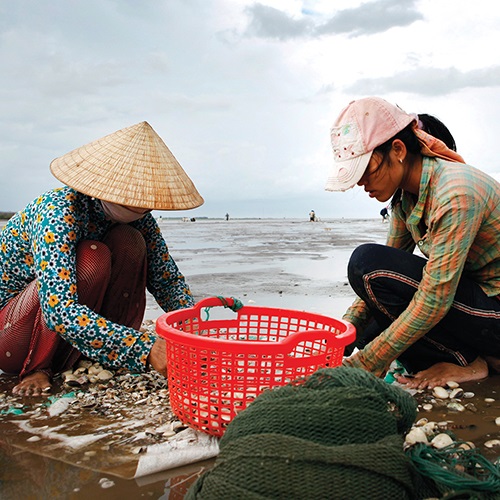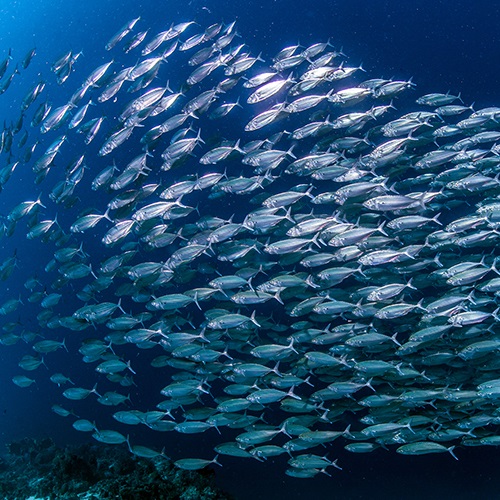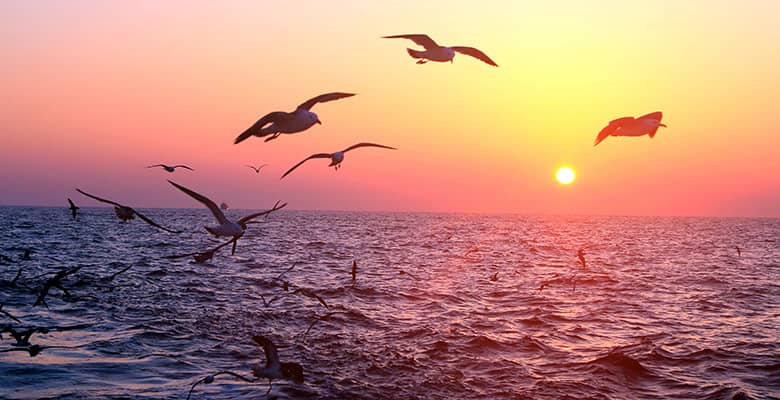Learn more about commercial fishing, how it impacts Australia and New Zealand, fishing quotas in our waters and its impact on coral reefs and our ocean.
What is commercial fishing?
Commercial fishing is where fish are caught for profit. The fish are caught in the ocean, lakes or rivers. Large-scale commercial fishing is also known as industrial fishing.
Commercial fishing started in the Middle Ages when fish were caught in larger numbers than could be consumed immediately. Prior to this fishing was primarily for subsistence. During the 20th century, advances in mechanised fishing meant the amount of fish caught increased significantly.In 2020, 97 million tonnes of fish were caught in an industry that employs 39 million people worldwide (UN SOFIA, 2020).
Is commercial fishing sustainable?
According to the United Nations, there's been a 14% rise in global capture fisheries production from 1990 to 2018.
This rise in fishing has meant that fish stocks within biologically sustainable levels have decreased from 90% in 1990 to 65.8% in 2018.
Despite this, sustainable fishing is possible.
Over 500 fisheries representing 17.4% of total global catch are certified to the MSC Fisheries Standard. These fisheries use a variety of fishing methods and gear types, including trawl nets, purse seines, dredges, pots and traps.
Many MSC certified fisheries have improved their sustainability by making modifications to their fishing gear:
- The Cornish hake fishery reduced marine mammal bycatch by adding acoustic pingers to gill nets.
- The Australia Northern Prawn trawl fisheries have implemented effective bycatch reduction devices to their nets. This includes the 'Tom's Fisheye', which creates a gap in the net for fish to escape. They have also reduced turtle bycatch by 99% through adding turtle exclusionary devices to trawl nets.
- South African offshore hake fishery reduced seabird bycatch by 90% by adding streamers known as bird-scaring lines, to fishing lines to deter seabirds from flying too close to the vessel.
Commercial fishing quotas
A fishing quota determines the amount of target fish that can be caught in a predetermined period. This is also known as Total Allowable Catch (TAC) or Individual Transferable Quota (ITQ).
- The fishing quota is usually specific to a species and is set for a fishing season
- Fishing quotas are a form of government regulation to ensure fair access and to prevent overfishing
- Fishing quotas can be bought and sold to allow commercial fishers to increase their catch.
In Australia’s Commonwealth fisheries (generally Australian fisheries operating beyond 3 nautical miles), quotas are an important tool within the management framework of the Australian Fisheries Management Authority (AFMA). In 2020, 95% of the Commonwealth’s fisheries by value were managed by quota (ITQ’s). The ITQ’s used in Australia’s Commonwealth fisheries help provide economic security to fishers and act as an ecological tool to safeguard marine biodiversity.
New Zealand’s fisheries management framework is based on the Quota Management System (QMS), requiring 98 species (comprised of 642 fish stocks) to be maintained at or above the biomass that can produce the Maximum Sustainable Yield (MSY). MSY is the largest average long-term annual catch that can be taken sustainably from a stock. New Zealand’s deep-water fisheries that are MSC certified have management targets that maintain stock sizes at or above the MSY.
Whilst quotas are a popular fisheries management tool, they are not the only way to demonstrate sustainability. Other fisheries certified to MSC requirements show good management through the restriction of fishing effort for example by limiting the season length or the amount of fishing gear that can be used. By using management tools that limit the inputs of a fishery, it is possible to limit the target catch similar to quotas which can lead to good ecological and economic outcomes.
Assessment to the MSC Fisheries Standard is accessible to all fisheries regardless of their approach to fishery management.
Commercial fishing for Western Rock Lobster
Australia’s Western Rock Lobster fishery targets the valuable western rock lobster (Panulirus Cygnus) year-round off the coast of Western Australia. Worth close to AUD$500m each year, this fishery is subject to strict management through the implementation of quotas, minimum and maximum sizes as well as a robust licensing regime.
The main market for Australia’s Western Rock Lobster is Asia where China accounts for the main market share. In recent years, the fishery is diversifying its markets with lobster products increasingly found for sale in Australian supermarkets, restaurants and also directly from fishers in what is called ‘back of boat sales’.
The Western Rock Lobster fishery was the first in the world to achieve MSC certification in 2000. The fishery has made many environmental improvements including a transition to quota, gear modifications to prevent interactions with Australian Sea Lions and the move toward a sustainable bait sourcing strategy.
Commercial tuna fishing
The fishing method behind MSC certified tuna caught in the waters of the PNA nations excludes the use of fish aggregating devices, or FADs – floating objects that attract tuna and other fish species.
In FAD fishing young tuna can be caught before they can reproduce, with an increased risk of other species ending up as bycatch. Tackling the problems associated with FAD fishing is critical to our ocean’s health and productivity.
Vessels working under the PNA MSC certification scheme set their nets around free-swimming schools of adult tuna. It’s a much more challenging quest – the fishers must hunt their prey across countless miles of the world’s largest ocean, checking the radar and scanning the horizon for the flocks of seabirds that signal the tunas’ presence.
Every vessel fishing PNA waters for MSC certified tuna must have an official MSC trained independent observer on board, checking that it’s abiding by the regulations and by the MSC’s chain of custody requirements.
These include science-based limits on the quantity of tuna that can be harvested, size restrictions, complete segregation during fishing trips and transhipment and bans on fishing in certain sensitive areas and around Fish Aggregating Devices FADs or whale sharks.
A remote monitoring system enables fisheries authorities to keep an eye on vessel movements and spot signs of illegal fishing and allows customers around the world to have access to full online traceability from sea to shelf.
Commercial mackerel fishing
Mackerel icefish are part of a group of species found exclusively in the Southern Ocean known as ‘white blooded’ fish. These species survive without the red oxygen-carrying pigment, haemoglobin, in their blood cells. This means their blood is colourless.
Mackerel icefish are distributed widely in sub-Antarctic latitudes, mainly around islands. They grow to around 44cm and are thought to live 4-5 years.
The Australia mackerel icefish fishery is located in the waters off Heard Island and McDonald Islands (HIMI), a remote group of volcanic islands in the Southern Ocean, 4,000km southwest of Perth.
The fishery is managed in line with guidance from the Convention on the Conservation of Antarctic Marine Living Resources (CCAMLR). This stipulates that over 75% of the available fish will remain uncaught, in order to maintain natural population patterns and to provide enough food for known predators.
The fishing method is demersal (bottom) and pelagic (mid-water) trawling. Trawl nets are limited to a minimum mesh size of 90mm when targeting mackerel icefish to enable juvenile fish to escape the net.
CCAMLR adopts both the 'precautionary approach' and the 'ecosystem approach' which require that all other living resources of the Southern Ocean are treated as an integrated system. It considers effects on the predator, prey and related species, takes decisions on sustainable harvesting levels on the basis of sound scientific advice, and avoids decisions that have a high risk of long-term adverse effects.
The HIMI region includes one of the largest marine protected areas in the world, covering 65,000km², with an additional 11,500km² being considered for inclusion. This means that 39% of all waters shallower than 1,000m around HIMI are no-fishing zones.
Commercial salmon fishing
The MSC certified Alaska salmon fishery targets five species of salmon in U.S. territorial waters off the coast of Alaska.Salmon hatch in freshwater, spend part of their life in the ocean and then migrate back to spawn in freshwater. Millions of salmon head to Alaska’s rivers during these salmon runs. All salmon die after spawning.
Sockeye salmon support one of the most important commercial fisheries on the Pacific coast of North America, representing about a quarter of the total salmon harvest. They are increasingly sought after in recreational fisheries and are a mainstay of many subsistence users.
Chinook salmon is Alaska's state fish and is one of the most important sports and commercial fish native to the Pacific coast of North America. It is the largest of all Pacific salmon, with individual fish commonly weighing over 30 pounds (13 kg).
Chum salmon are the most abundant commercially harvested salmon species in the Arctic, northwestern, and interior Alaska.
The other species harvested are coho salmon and pink salmon, the smallest species.
Salmon are harvested by nets (drift and set gillnets, purse seine), trolling and fishwheels. Trolling is fishing by drawing a baited line or lure behind a boat. A fishwheel operates much like a water-powered mill wheel: fish travelling upstream are caught in baskets on the wheel, then transferred into a holding tank.
Commercial fishing in Australia & New Zealand
- Commercial fishing in Australia and New Zealand contribute significantly to the economy
- The value of Australian fishery production was AUD$1.71 billion in 2016–17, according to the Australian Bureau of Agricultural Resource Economics and Sciences (ABARES).
- New Zealand’s commercial fishing industry was worth NZD$4.18 billion in 2017 according to Business and Economic Research Ltd.
- A high proportion of fish caught in Australia and New Zealand is exported. Around half of Australia’s fish and aquaculture products are exported (AUD$1.58bn, 50,741 tonnes). In New Zealand, around 60% of seafood is exported (NZD$2.0bn, 267,901 tonnes)
- Commercial fishing in Australia and New Zealand isn't evenly distributed. Key fishing grounds are often linked to areas of high marine productivity such as the Bass Straits or the Gulf of Carpentaria in Australia and around the Auckland Islands or the Cook Strait in New Zealand. Fishing productivity and commercial catch then gets focussed through key landing ports in Australia and New Zealand. Key ports of landing in Australia include Lakes Entrance (VIC), Geraldton (WA) and Mooloolaba (QLD). In New Zealand, Nelson, Tauranga and Lyttleton (Christchurch) are all key fishing ports.
- Fisheries in Australia and New Zealand are largely considered sustainable with almost 50% of wild catch MSC certified
- There are 37 fisheries (32 species) in Australia and nine (eight species) in New Zealand that are MSC certified.
Impacts of commercial fishing
Commercial fishing provides people with food, income and employment. However, unsustainable fishing is a major global challenge that threatens ocean wildlife, livelihoods and seafood for future generations.
Given the scale of commercial fishing globally, risks can include:
- Overfishing including illegal, unregulated and unreported fishing
- Bycatch
- Loss of endangered, threatened and protected species
- Plastic pollution from abandoned fishing gear
However, there are solutions to overfishing and unsustainable fishing including:
Find out more

Our collective impact
For over 20 years fisheries, scientists, consumers and industry have been part of a collective effort to make sure our oceans are fished sustainably.

What is sustainable fishing?
Sustainable fishing means leaving enough fish in the ocean, respecting habitats and ensuring people who depend on fishing can maintain their livelihoods.


